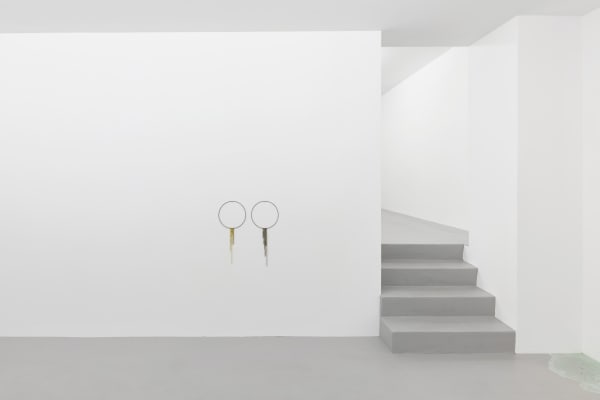MONIKA EMMANUELLE KAZI: Room with a View
Past exhibition
Press Release
Room with a View marks the occasion of Monika Emmanuelle Kazi’s first solo exhibition in Zurich.
To list the shows contents in the most basic terms, we have window frames, postcards, metal rings with chains, evaporated water, mirrors and light. They are undeniably present in the space with the viewer. We also have complex framings of personal and political history, breaking of dimensions, exploration of craft and the trade thereof. At the next level – which is both macro and micro – we may experience a sustained sensation of being held.
Kazi’s work is instantly recognisable. Not by processes of production, motifs or materials (which are exponentially expanding), but by a viscerally recognisable mode of how to hold things carefully and precisely. This occurred in previous works by taking water as a material, whether as tears, bathing water or from a geographical context. What was under scrutiny, is how water requires a boundary to be grasped by the human: how to frame this element, far more complex than us, reducing it to quotidian terms.
Water as a substance is gone, but Kazi’s practice continues to hold ideas and their implicit materials like small dams or reservoirs, any error in that barrier risks spillage and losing the work completely, just as water escapes into soil.
The centre piece of the first room is a large, free-standing window frame, its shutters are replaced by tropical foliage. Turning the scenery, that which is flattened in the eye into physical form allows the work to have its own flexibility. In theory, it can be manipulated to either fold back onto itself, traditionally frame the silhouetted foliage, or not – by breaking from the two-dimensional, the window is enabled to self-support. The view becomes a rigid slice in the room, disrupting any sense of dimensional hierarchy. In the second space is a smaller, wall-based window frame. Meeting this work at eye-level, we can see the dominance of the cross and its wide-ranging role as the symbol or the Christian faith, as it marched across the globe and the Swiss Flag itself, so fixed but very slippery.
What is a window? Kazi describes the window as what becomes before a door in the most rudimentary of domestic spaces. A window is the removal of external wall that creates exchange with the outside world. A window is a tool that allows for visual and mental movement ahead of the physical. It is a frame and an obstacle, and it takes great pleasure in that. The domestic window is not a space for the crowd, it is for a single viewer in dialogue.
The wood chosen for the window pieces comes from Congo, the familial home of Kazi’s family. There is an ambiguity of choice here: is the draw to the material inscribed within the artist for its familiarity or merely a happy coincidence of meeting and sharing in a common ground?
The metal rings with chains mark consideration of the small cast metal replicas of the Eiffel Tower, sold by immigrants to tourists, made by low paid workers somewhere undisclosed overseas. No party in the exchange is rooted in Paris. The empty rings may signal a very good days sales and robust exchange but also a physical and material exhaustion. Their emptiness offers a portal to think about sites of previous trade: the history of Congo as a pre-slavery trading partner with France, in the 15th century, binding the countries in a special diplomatic relationship: a one-to-one conversation that saw the export of specific forms of craft and material. The complexity of this is a point of concentrated study, undertaken by the artist, beyond common conversation and merely marked by what is missing.
The exhibition title Room with a View can be taken as the way we might opt for the picturesque in a hotel booking – and send back a postcard as an aide memoire. In conversation, Kazi frequently used to the term ‘home’ but the location of that site sustains flexibility: France, Congo, her current home in Switzerland. Home often referring to wherever she is not.
I feel there are no bodies in this exhibition, yet there are three portraits silvered into the cloud-shaped mirrors. They are taken from a photograph the artist took of her parents at the age of 11 or 12, the photo is from a similar era and location, as the image on the postcards stacked nearby. A lot of Kazi’s works turn me inside out, I feel inverted just as her parent appear in the mirror, what I’m looking at directs me to the void and placed in a timeline, I can’t break from. Fixed facts need to be acknowledged to allow mental movement, just as we have to negotiate the objects shared with us in this space. I am undone, just as the water has evaporated and left a theatrical trace of itself. My behaviour as a viewer is understood as a material and stretched to its limits. Kazi’s work is powerfully on her terms, she frames us, watches us, choreographs us within the orangeness of her gaze. Room with a View implies spectacle but more sensitively, offers the intimacy of exchange via use of the window, the souvenir, the postcard. As a whole, Room with a View generates the hydro-electric charge of eye contact, rather than the mass spectacle: The exhibition is a deftly framed interaction with a dialogue, rather than dictate, which Kazi’s graces us with through craft, language and focussed generosity. – Anthea Hamilton
Installation Views





















